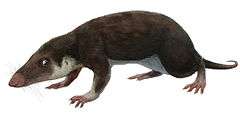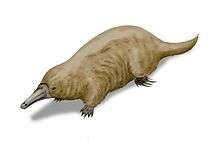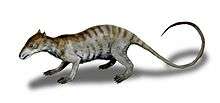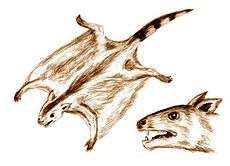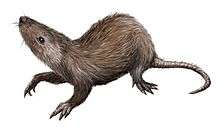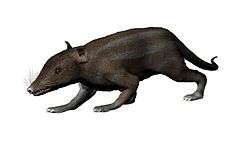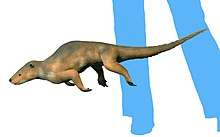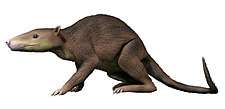Adelobasileus
Adelobasileus is a genus of mammal-like synapsid from the Late Triassic (Carnian), about 225 million years ago. It is known only from a partial skull recovered from the Tecovas formation in western Texas, southern United States, referred to the species Adelobasileus cromptoni.
| Adelobasileus | |
|---|---|
 | |
| Scientific classification | |
| Kingdom: | Animalia |
| Phylum: | Chordata |
| Clade: | Therapsida |
| Clade: | Cynodontia |
| Genus: | †Adelobasileus Lucas & Hunt, 1990 |
| Species: | †A. cromptoni |
| Binomial name | |
| †Adelobasileus cromptoni Lucas & Hunt, 1990 | |
Roughly contemporary with the mammaliaform Tikitherium, Adelobasileus predates the non-mammalian cynodonts Tritylodontidae and Tritheledontidae by 10 million years. In fact, distinct cranial features, especially the housing of the cochlea, suggest that Adelobasileus is a transitional form in the character transformation from cynodonts to Triassic mammals. For this reason, it is thought to be the common ancestor of all modern mammals or a close relative of the common ancestor. Though traditionally classified as a mammal by trait-based taxonomy, it is outside the crown group containing all true mammals.[1]
References
- Rowe, T. S. (1988). "Definition, diagnosis, and origin of Mammalia" (PDF). Journal of Vertebrate Paleontology. 8 (3): 241–264. doi:10.1080/02724634.1988.10011708.
Sources
- Lucas, SG; Hunt, AP (1990). "The oldest mammal". New Mexico Journal of Science. 30 (1): 41–49.CS1 maint: ref=harv (link)
- Lucas, SG; Luo, Z (September 1993). "Adelobasileus from the upper Triassic of west Texas: the oldest mammal". J. Vert. Paleontol. 13 (3): 309–334. doi:10.1080/02724634.1993.10011512.
